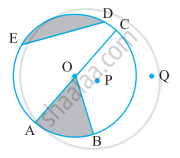Advertisements
Advertisements
प्रश्न
In the adjoining figure, AC is a diameter of the circle. AP = 3 cm and PB = 4 cm and QP ⊥ AB. If the area of ΔAPQ is 18 cm2, then the area of shaded portion QPBC is ______.
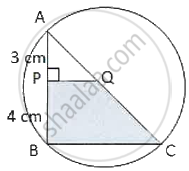
विकल्प
32 cm2
49 cm2
80 cm2
98 cm2
उत्तर
In the adjoining figure, AC is a diameter of the circle. AP = 3 cm and PB = 4 cm and QP ⊥ AB. If the area of ΔAPQ is 18 cm2, then the area of shaded portion QPBC is 80 cm2.
Explanation:

Given:
1. AC is the diameter of the circle.
2. AP = 3 cm, PB = 4 cm and QP ⊥ AB.
3. The area of ΔAPQ is 18 cm2.
4. The area of the shaded portion QPBC is 80 cm2.
Let's denote some points:
- A, P, B lie on a straight line (since QP ⊥ AB).
- Q is the point on QP where QP is perpendicular to AB.
1. Area of ΔAPQ
The area of ΔAPQ is given as 18 cm2.
For a right-angled triangle, the area is given by:
Area = `1/2 xx "base" xx "height"`
Here, AP (3 cm) can be considered the base, and QP (h) can be considered the height:
18 = `1/2 xx 3 xx h`
Solving for h:
18 = `3/2 xx h`
h = `(18 xx 2)/3`
h = 12 cm
So, QP = 12 cm.
2. Verify the total area of QPBC
To find the area of the shaded portion QPBC, we need to consider the area of quadrilateral QPBC.
3. Diameter and Radius of the Circle
Since AC is the diameter of the circle, we need to find the length of AC.
Note that P divides AB into AP and PB.
AB = AP + PB
= 3 + 4
= 7 cm
Since QP ⊥ AB, the coordinates of point C (considering A and B are on the x-axis) imply that the radius of the circle is half the length of AC.
Given that the total area of QPBC is 80 cm2, we can consider it directly for further calculations. However, typically, you would calculate the areas of respective segments.
APPEARS IN
संबंधित प्रश्न
In fig.. O is the center of the circle and BCD is tangent to it at C. Prove that ∠BAC +
∠ACD = 90°
true or false
Sector is the region between the chord and its corresponding arc.
In the given figure, O is the centre of the circle. If ∠AOB = 140° and ∠OAC = 50°; find:
- ∠ACB,
- ∠OBC,
- ∠OAB,
- ∠CBA.
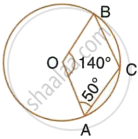
In the given figure, the chord AB of the larger of the two concentric circles, with center O, touches the smaller circle at C. Prove that AC = CB.
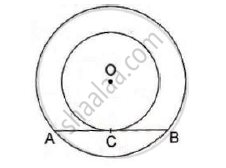
In the given figure, an isosceles triangle ABC, with AB = AC, circumscribes a circle. Prove that point of contact P bisects the base BC.

In the given figure, PA and PB are two tangents to the circle with centre O. If ∠APB = 60° then find the measure of ∠OAB.

In the given figure, AB is a diameter of a circle with centre O and AT is a tangent. If \[\angle\] AOQ = 58º, find \[\angle\] ATQ.
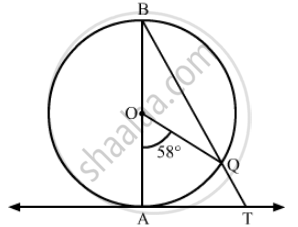
Draw circle with diameter: 8.4 cm
In above case, measure the length of the radius of the circle drawn.
In a circle with centre P, chord AB is parallel to a tangent and intersects the radius drawn from the point of contact to its midpoint. If AB = `16sqrt(3)`, then find the radius of the circle
From the figure, identify a chord.
